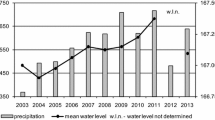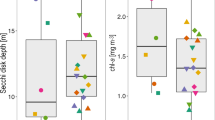Abstract
The research was carried out in a mesotrophic and dimictic lake during winters with ice cover. In the last forty years, the development of phytoplankton was analyzed in five extreme winter seasons. The studies of phytoplankton characteristics in the water column took into account values of biomass, concentration of chlorophyll-a and species composition, including dominant species. Differences in the vertical distribution of flagellate and non-flagellate species belonging to cyanobacteria and algae were analyzed in the gradient of light and thermal conditions. The phytoplankton biomass was low and vertically differentiated, with the lowest values at the deeper part of the water column. Flagellate species from the group of Cryptophyceae, Chrysophyceae and Dinophyceae were most abundant. Species biodiversity was low but every winter the dominant species represented different taxonomic groups. In some periods, larger non-motile phytoplankton species from green or blue-green algae dominated. The research proved that the development of phytoplankton under the ice cover was limited mainly by light and, to a lesser extent, by temperature.
Similar content being viewed by others
References
Agbeti, M.D. & Smol J.P. (1995). Winter limnology: a comparison of physical, chemical and biological characteristic in two temperate lakes during ice cover. Hydrobiologia 304:221–234. DOI: 10.1007/BF02329316.
Babanazarova O., Siddelev S. & Schischeleva S. (2013, September). The structure of winter phytoplankton in Lake Nero, a hypertrophic lake dominated by Planktothrix-like Cyanobacteria. Aquatic Biosystems 9: 18. Retrieved September 30, 2013, from PMC database on the World Wide Web: http://www.ncbi.nlm.nih.gov/pmc. DOI:10.1186/2046-9063-9-18.
Barone, R. & Naselli-Flores L. (2003). Distribution and seasonal dynamics of Cryptomonads in Sicilian water bodies. Hydrobiologia 502: 325–329. DOI: 10.1023/B:HYDR.0000004290.22289.c2.
Bucka, H. & Wilk-Woźniak E. (2003). Morphology and ecology of selected coccal green algae occurring in different types of water bodies. Biologia 58(4): 483–487.
Butler, H.G., Edworthy M.G. & Ellis-Evans J.C. (2000). Temporal plankton dynamics in an oligotrophic maritime Antarctic Lake. Freshwater Biology 43: 215–230. DOI: 10.1046/j.1365-2427.2000.00542.x.
Danilov, R.A. & Ekelund N.G.A. (2001). Phytoplankton communities at different depths in two eutrophic and two oligotrophic temperate lakes at higher latitude during the period of ice cover. Acta Protozool. 40: 197–201.
Dokulil, M.T. & Herzig A. (2009). An analysis of long-term winter data on phytoplankton and zooplankton in Neusiedler See, a shallow temperate lake, Austria. Aquatic Ecology 43(3): 715–725. DOI: 10.1007/s10452-009-9282-3.
Eloranta, P. (1982). Seasonal succession of phytoplankton in an ice-free pond warmed by a thermal power plant. Hydrobiologia 86: 87–91. DOI: 10.1007/BF00005792
Fritsen, Ch.H & Priscu J.C. (1999). Seasonal change in the optical properties of the permanent ice cover on Lake Bonney, Antarctica: Consequences for lake productivity and phytoplankton dynamics. Limnol. Oceanogr. 44(2): 447–454.
Hillebrand, H., Dürselen C.D., Kirschtel D., Pollingher U. & Zohary T. (1999). Biovolume calculation for pelagic and benthic microalgae. Journal of Phycology 35: 403–424. DOI: 10.1046/j.1529-8817.1999.3520403.x.
Kaszewski, B.M. (2002). Climatic conditions of Polesie National Park. In S. Radwan (Ed.), Polesie National Park. Nature monograph. (pp. 19–28). Lublin: Morpol Press.
Kiili, M., Pulkkanen M. & Salonen K. (2009). Distribution and development of under-ice phytoplankton in 90-m deep water column of Lake Päijänne (Finland) during spring convection. Aquatic Ecology 43(3): 707–713. DOI: 10.1007/s10452-009-9262-7.
Kremp, A. & Anderson D.M. (2000). Factors regulating germination of resting cysts of the spring bloom dinoflagellate Scrippsiella hangoei from the northern Baltic Sea. Journal of Plankton Research 22(7): 1311–1327. DOI: 10.1093/plankt/22.7.1311.
Krupa, D. & Czernaś K. (2003). Mass appearance of cyanobacterium Planktothrix rubescens in Lake Piaseczno, Poland. Water Quality Research Journal of Canada 38(1): 141–152.
Lecewicz, W., Sokołowska W. & Wojciechowski I. (1973). The changes of winter phytoplankton in relation to the light climate in the lakes with various trophy. Ekol. Pol. 13: 193–208.
Leppäranta, M., Reinart A., Erm A., Arst H., Hussainov M. & Sipelgas L. (2003). Investigation of ice and water properties and under-ice light fields in fresh and brackish water bodies. Nordic Hydrology 34(3): 245–266. DOI:10.2166/nh.2003.015.
Lizotte, M.P& Priscu J.C. (1992). Photosynthesis-irradiance relationships in phytoplankton from the physically stable water column of a perennially ice-covered lake (Lake Bonney, Antarctica). Journal of Phycology 28(2): 179–185. DOI: 10.111/j.0022-3646.1992.00179.x.
McKnight, D.M., Howes B.L., Taylor C.D. & Goehringer D.D. (2000). Phytoplankton dynamics in a stably stratified Antarctic lake during winter darkness. Journal of Phycology 36(5): 852–861. DOI: 10.1046/j.1529-8817.2000.00031.x.
Mitrofanova, E.Y., Kirillov V.V. & Kotovshchikov A.V. (2007). Phytoplankton below the ice cover in Lake Telestkoye, a deep oligotrophic lake in western Siberia. Lakes & Reservois: Research & Management 12(3): 129–134. DOI: 10.1111/j.1440-1770.2007.00333.x.
Nõges, P., Adrian R., Anneville O., Arvola L., Blenckner T., George G., Jankowski T., Järvinen M., Maberly S., Padisák J., Straile D., Teubner K. & Weyhenmeyer G. (2010). The Impact of Variations in the Climate on Seasonal Dynamics of Phytoplankton. In D. G. George (ed.), The Impact of Climate Change on European Lakes. Aquatic Ecology, Series 4: 253–274. DOI:10.1007/978-90-481-2945-4_14.
Nush, E.A. (1980). Comparison of different methods for chlorophyll and pheopigment determination. Arch. Hydrobiol. Beih. Ergebn. Limnol. 14: 14–36.
Péterfi, L.Ş. & Momeu L. (2009). Ecology and biodiversity conservation of the Romanian Synurophyceae. Contributii Botanice 46:107–117.
Phillips, K.A. & Fawley M.W. (2002a) Winter phytoplankton blooms under ice associated with elevated oxygen levels. Journal of Phycology 38: 1068–1073. DOI:10.1046/j.1529-8817.2002.01044.x.
Phillips, K.A. & Fawley M.W. (2002b). Winter phytoplankton community structure in three shallow temperate lakes during ice cover. Hydrobiologia 470: 97–113. DOI:10.1023/A:1015667803372.
Reynolds, C. (2006). The ecology of phytoplankton. Ecology, biodiversity and conservation. Cambridge: University Press.
Richardson, T.L., Gibson Ch.E. & Heaney S.I. (2000). Temperature, growth and seasonal succession of phytoplankton in Lake Baikal, Siberia. Freshwater Biology 44(3): 431–440. DOI: 10.1046/j.1365-2427.2000.00581.x.
Siver, P.A. (1991). The biology of Mallomonas. Morphology, Taxonomy and Ecology. Developments in Hydrobiology 63: 1–230. DOI: 10.1007/978-94-011-3376-0_5.
Squires, L.E. & Rushforth S.R. (1986). Winter phytoplankton communities of Utah Lake, Utah, USA. Hydrobiologia 131: 235–248. DOI: 10.1007/BF00008859.
Talling, J.F. (1993). Comparative seasonal changes, and inter-annual variability and stability, in a 26-year record of total phytoplankton biomass in four English lake basins. Hydrobiologia 268: 65–98. DOI: 10.1007/BF00006879.
Utermöhl, H. (1958). Zur Vervolkommnung der quantitativen Planktonmethodik. Mitt. Int. Ver. für Theor. Angew. Limnol. 9: 1–38.
Vehmaa, A. & Salonen K. (2009). Development of phytoplankton in Lake Pääjärvi (Finland) during under-ice convective mixing period. Aquatic Ecology 43: 693–705. DOI: 10.1007/s10452-009-9273-4.
Wetzel, R.G. (2001). Limnology. Lake and river ecosystems. San Diego, San Francisco, New York, Boston, London, Sydney, Tokyo: Academic press.
Wiedner, C. & Nixdorf B. (1998). Success of chrysophytes, cryptophytes and dinoflagellates over blue-greens (cyanobacteria) during an extreme winter (1995/96) in eutrophic shallow lakes. Hydrobiologia 369/370: 229–335. DOI: 10.1023/A:1017054011389.
Wilgat, T., Michalczyk Z., Turczyński M. & Wojciechowski K. (1991). Łęczna-Włodawa Lakes. Studia Ośr. Dok. Fizjogr. PAN 19: 23–140. (in Polish).
Wojciechowska, W (1976). Dynamics of phytoplankton biomass in two lakes of a different limnological character. Ekol. Pol. 24(2): 237–252.
Author information
Authors and Affiliations
Corresponding author
About this article
Cite this article
Wojciechowska, W., Lenard, T. Effect of extremely severe winters on under-ice phytoplankton development in a mesotrophic lake (Eastern Poland). Ocean and Hydro 43, 147–153 (2014). https://doi.org/10.2478/s13545-014-0127-x
Received:
Accepted:
Published:
Issue Date:
DOI: https://doi.org/10.2478/s13545-014-0127-x




